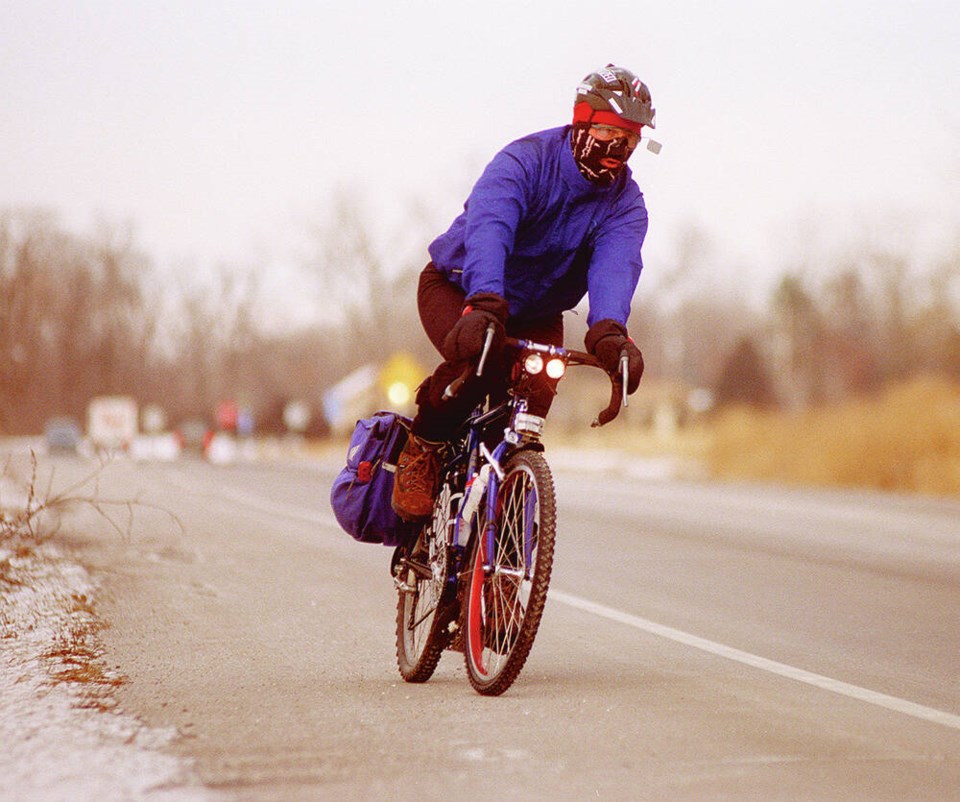Of course I’m all for safety on the road. But are there times when we overdo it? In a few instances: Yes.
One example that comes to mind as evening darkness grows is excessively bright bicycle lights. Bikes need to be seen but when your handle bar light approximates the strength of a landing light on an Airbus 380 passenger liner something’s not right.
There’s often a lot of grumbling from motorists that cyclists are not visible enough and technology has responded — at least for those who take the trouble to install lights on their bikes in the first place. The problem is that the pendulum has swung too far in some cases.
I’m really down on the proliferation of dazzle headlights in cars. But it seems like bikes are also entering the dazzle parade in earnest. There’s an oncoming source of light. It’s sometimes difficult to figure out what it is though. All you can see is a blinding aura. It might be a car with one headlight out, or a cyclist, or even a gaggle of cyclists — who knows?
It’s worse if it’s a flashing light. That one I really don’t get. While flashing white bike lights aren’t illegal in ÎÚÑ»´«Ã½ they aren’t recommended.
It’s especially hard for oncoming human eyes to discern distance in the face of bright or bright flashing lights. It is also a general distraction for other drivers. We don’t allow for that kind of flashing light performance on motor vehicles for that very reason. Vehicle high beams are designed specifically to turn on and off on demand by the driver — and it’s illegal to keep them on when approaching oncoming traffic. Very few bike lights offer that option.
Many of the cycling forums I’ve looked at recommend a white light brightness of 100 lumens for night cycling in an urban area with standard street lighting. If your commute is through intermittently darkened areas and you need to see the road in front of 250 to 300 lumens is good. For those who trail ride or who are proceeding in truly “black” areas 300 to 500 lumens are recommended.
It’s also important to ensure that your front light is adjusted properly. If you’re lighting up reflective road signs, which stand a metre or two above the road surface — your light is probably shooting too high.
A simple test to gauge that is to have a partner hold your bike up with its light on and then go and stand in front of it. According to a couple of cycling blogs I’ve looked at, many riders are surprised by the intensity of their own lights. Some next gen trail bike lights can blast out 1600 lumens. Great for that night time foray through blackened trails, but totally inappropriate for urban use.
ÎÚÑ»´«Ã½ is late to the game in regulating next generation cycling lights but several jurisdictions throughout North America now make it illegal to use lighting which dazzles, confuses or distracts other road users by endangering their safety.
For rear lights, ÎÚÑ»´«Ã½’s motor vehicle act requires a rear mounted red light, which actually is allowed to flash. That one I can agree with. On darkened winter streets picking up on a cyclist as you approach from behind, as early as possible, is a good thing. Red lights don’t seem to have the blinding dazzle intensity of white ones. Bikes also require a red reflector in addition to a red light visible from the rear.
Another problem for me is that some riders, seeking to stand out, use non-standard colours of headlights like red, blue or green. While driver’s may pick you up quicker, that doesn’t make you safer. Cyclists need to be identified as a vehicle. Motorists are used to identifying standard lighting colours. Red goes on the back of vehicles, white on the front. Blue and red are for emergency responders. Motorists confronted with red on the front of a bicycle, or white on the back, may react to the colour rather than the actual actions of the bicycle.
Glove Box: It’s October already. Time to think about snow tires again. Many roads in ÎÚÑ»´«Ã½, including here on the island, now require vehicles to be equipped for winter. “November through January is the most dangerous time of year. Work-related crashes resulting in injury and time-loss claims during those months increase by 26% compared with the rest of the year, according to WorkSafeBC statistics”, says to Gord Woodward communications manager for Road Safety at Work. Many people wait too long to make the winter switch. Time to change tires and fluids as well as making sure routine winter maintenance is done. Don’t be part of a viral snow mayhem video this winter because you left things too late.



